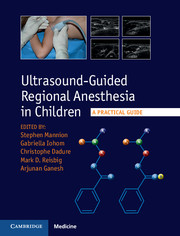Book contents
- Frontmatter
- Contents
- List of contributors
- 1 Introduction
- Section 1 Principles and practice
- Section 2 Upper limb
- Section 3 Lower limb
- 11 Ultrasound-guided femoral nerve block
- 12 Ultrasound-guided saphenous nerve block
- 13 Ultrasound-guided sciatic nerve block
- Section 4 Truncal blocks
- Section 5 Neuraxial blocks
- Section 6 Facial blocks
- Appendix: Muscle innervation, origin, insertion, and action
- Index
- References
13 - Ultrasound-guided sciatic nerve block
from Section 3 - Lower limb
Published online by Cambridge University Press: 05 September 2015
- Frontmatter
- Contents
- List of contributors
- 1 Introduction
- Section 1 Principles and practice
- Section 2 Upper limb
- Section 3 Lower limb
- 11 Ultrasound-guided femoral nerve block
- 12 Ultrasound-guided saphenous nerve block
- 13 Ultrasound-guided sciatic nerve block
- Section 4 Truncal blocks
- Section 5 Neuraxial blocks
- Section 6 Facial blocks
- Appendix: Muscle innervation, origin, insertion, and action
- Index
- References
Summary
Clinical use
In children, lower limb surgery is commonly performed. The surgical correction of congenital orthopedic malformations is very painful as bony surgery is often required. The use of sciatic nerve block is common for post-operative analgesia after ankle or foot surgeries (arthrodesis or clubfoot repair) in pediatrics. In emergency surgery (ankle/foot fracture or amputation), it can be useful to combine sciatic nerve block with general anesthesia or sedation. However, care must be exercised in the use of peripheral nerve blockade in patients at risk of acute compartment syndrome (Mannion and Capdevila, 2010).
The sciatic nerve is a motor and sensory nerve consisting of the tibial and common peroneal nerves. It innervates the posterior aspect of the thigh and knee and all of the leg and foot except for the medial aspect of the calf and a small patch of skin between the first and second toes, which are innervated by the saphenous nerve. Subgluteal approaches to sciatic nerve blockade are useful for knee surgery, particularly if combined with complete or partial (saphenous nerve) blockade of the femoral nerve.
Ultrasound guidance expands the use of sciatic nerve block in pediatric regional anesthesia and allows for improvements in post-operative rehabilitation with continuous peripheral nerve catheters (Ponde et al., 2010; Van Geffen et al., 2010), especially in children with congenital orthopedic conditions (Ponde et al., 2013). Ultrasonography is able to visualize the sciatic nerve along its entire length and therefore blockade can be performed at a number of sites. The most common sites are the subgluteal and popliteal areas.
Ultrasound-guided sciatic nerve block improves success rates and prolongs the sensory blockade compared to traditional techniques (Oberndorfer et al., 2007).
Clinical sonoanatomy
The sciatic nerve arises from the sacral and lumbar plexus (fourth and fifth lumbar nerves join the first, second and third sacral nerves). It exits from the pelvis through the greater sciatic foramen, then descends between the great trochanter and ischial tuberosity until the apex of the popliteal fossa where it divides into two different nerves: the tibial nerve and the common peroneal nerve, which are contained within a common sheath (Figure 13.1). This site of the bifurcation is subject to significant anatomic variation (Schwemmer et al., 2004).
- Type
- Chapter
- Information
- Ultrasound-Guided Regional Anesthesia in ChildrenA Practical Guide, pp. 95 - 100Publisher: Cambridge University PressPrint publication year: 2015



